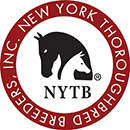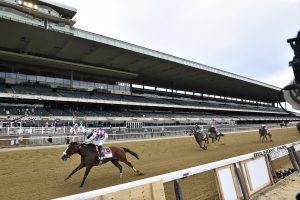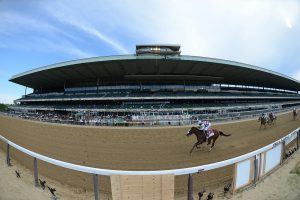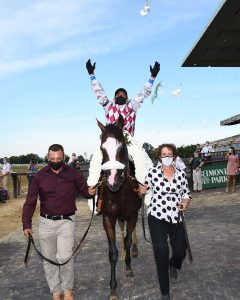Courtesy of The Saratoga Special/This Is Horse Racing
Barclay Tagg eased his weight against the front rail of his box – the third he sat in at the near-empty Belmont Park Saturday afternoon – and fixed his eyes to the infield screen while the minutes ticked down to post for the 152nd Belmont Stakes.
Robin Smullen, Tagg’s longtime assistant and partner, pinned her binoculars to her face while she leaned back in her seat.
If they weren’t dressed for the races or if an NBC cameraman wasn’t standing just out of the line of sight recording the scene it wouldn’t be a stretch to think the scene was cut from a typical morning at the racetrack.
Their nearest peers – Hall of Fame trainer Bill Mott and his wife Tina – sat in a box maybe 75 feet away doing much the same. The only others nearby were four reporters from a small pool of 15 invited to the spectator-free Belmont. The other scribes found spots closer to the finish post, where another group of horsemen including Todd Pletcher settled into their seats with the proper amount of social distancing.
Everyone sat or stood in near silence, a stark contrast to a few recent Belmonts that attracted crowds approaching 90,000 when American Pharoah and Justify completed recent Triple Crown sweeps and a little further back when 120,000 strong tried to will Smarty Jones over the finish in his near-miss in 2004.
They all watched the Belmont’s 10 runners go through their final warm-ups before taking the first steps on the 2020 Triple Crown that won’t be forgotten thanks to significant alterations in a race that usually tests champions in a place that reveres them more than most.
The coronavirus pandemic changed a lot of that – and so much about life for everyone in 2020 – yet none of that mattered much while those minutes turned into seconds for Tagg and Smullen.
Tagg went to his binoculars when the infield screen read 0 minutes to post. While he watched Manny Franco give Sackatoga Stable’s Tiz The Law a few more turns behind the starting gate almost a half-mile away, the only sounds from the stand were mumbled conversations, chirps from birds that took up residence in the steel and concrete ceiling above and the ongoing prattle of the in-house analysts opining the looks and credentials of the field.
Tiz The Law had the other nine beat on both accounts and ran to it in the Belmont’s shortened 9 furlongs, delivering a performance that surely will see an undeserving asterisk attached to the victory. Tiz The Law and Franco won by 3 3/4 lengths from Dr Post with Max Player another 1 1/2 lengths back in third. The winner, a son of Constitution bred in New York by Twin Creeks Farm, ran the 9 furlongs in 1:46.53 on the fast track that played that way all afternoon.
“It looked to me like everything just worked like clockwork,” Tagg said of Tiz The Law’s third Grade 1 win and second at Belmont. “That’s the way the horse likes to run, that’s the position he likes to be in, Manny knows the horse very well, we discussed it very quickly before I put him up on the horse, I felt very confident that Manny would ride him that way. It worked out and I’m very happy with it.”
Tagg, a former steeplechase jockey and respected horseman known for his patience and instincts, didn’t show a bit of anxiousness watching the Belmont through his binoculars. He started watching the race directly as the field broke from the 1 1/8-mile pole at the far corner of the expansive Belmont grounds before shifting to watching on the infield monitor through the binocs. He shifted back again when the field went into the far turn, with Tap It To Win and John Velazquez leading through after early splits of :23.11, :46.16 and 1:09.94.
Tiz The Law, sent off at 4-5, raced third behind Tap It To Win and California-based longshot Fore Left down the backstretch before inching up with ease past the opening 6 furlongs.
Tagg and Smullen stood up when the field turned for home, the latter making the first move while Franco made his.
“Come on Tizzy, come on Tizzy,” Smullen said, breaking the muted scene.
Before NYRA announcer John Imbriale could call the inevitable while Tiz The Law drew off, Smullen slung the strap of her binoculars over her shoulder, grabbed Tagg by his, squeezed a few times and set off down the aisle to the horsemen’s steps leading to the winner’s circle.
A few congratulations and claps of applause filled the air and within seconds everything went quiet again. The field galloped out, 39 1/4 lengths stretching from Tiz The Law to the last-place Jungle Runner, a strung-out group that saw Dr Post earn a classic placing in his fourth start and first graded try, Max Player finish third in his first start since the Grade 3 Withers Feb. 1 and Pneumatic check in fourth. The rest, including Tap It To Win in fifth and Grade 3 Sam F. Davis winner Sole Volante, were beaten double-digit lengths.
“I was pretty confident by the time we hit the seven-eighths pole,” said Franco, winning his first classic about seven months after his first Breeders’ Cup victory aboard Sharing at Santa Anita Park. “He was so kind and relaxed for me. He was so comfortable and never got keen. That was the key.
“I’m very happy for the opportunity that the owner and trainer have given me; I’m in good hands. They know what they’re doing and the horse is really good. I’m not going to lie I was little bit nervous [in the gate], but at the same time I was confident because I know what I have under me. Like I said, I’m in good hands with Barclay.”
Tagg conceded that he let his own confidence creep in that he’d win his first Belmont about 100 yards from the finish. He later changed the answer when asked about watching Franco look back at about the quarter-pole, scanning for competition that never arrived.
“I should have said 300 yards,” Tagg joked to a well-spaced group of print and TV journalists assembled in the Belmont Café in the clubhouse. “I thought if he’s what we think he is this is right where I’d like him to be and right where I’d like him to move. It all just worked out to perfection.”
Tagg’s preparation for Tiz The Law’s classic score also worked to perfection, although far from customary, typical, regular or normal. Pick your adjective; they all seem to apply to 2020.
Tiz The Law’s course toward the traditional opening jewel of the Triple Crown – the Kentucky Derby – started after a troubled third in Churchill Downs’ Grade 2 Kentucky Jockey Club late last November. Tagg and Jack Knowlton of Sackatoga Stables picked the Kentucky race instead of the Breeders’ Cup Juvenile – where Tiz The Law might have been one of the favorites off a 4-length win in the Grade 1 Champagne at Belmont – to get a run over the track in Louisville.
The team went to Florida after that race, to Tagg’s usual wintertime base at Palm Meadows Training Center in Boynton Beach and Tiz The Law trained to his ability. He won the Grade 3 Holy Bull at Gulfstream Park in his 2020 debut, despite some trouble and jumped up the list of top contenders for the May 2 Kentucky Derby.
They purposely skipped the Fountain of Youth, the next step on Gulfstream’s path to the Kentucky Derby, and set sights on the Florida Derby. That would give Tiz The Law eight weeks between races and then five weeks until the Kentucky Derby, which Sackatoga and Tagg won in 2003 with Funny Cide.
Enter Covid-19.
Training and racing schedules were thrown for a loop in March as tracks closed, canceled meetings and Churchill Downs made the decision March 17 to postpone the Kentucky Derby until Sept. 5. Already on track for the Florida Derby, Tagg and Knowlton stayed the course and Tiz The Law rolled to a 4 1/4-length win in front of a spectator-free grandstand at Gulfstream March 28.
Eventually more tracks returned to racing or stayed open, including Oaklawn Park, which shifted its Arkansas Derby to the first Saturday in May. That could have been an option but Tagg passed, continuing to train Tiz The Law with hopes the rumors he’d heard that the Belmont would be run at a shorter distance in June with the Travers moved from late August to early August.
Instead of going to the post for the Kentucky Derby as the favorite – or at least one of the favorites – Tiz The Law breezed 5 furlongs at Palm Meadows May 2 in 1:01.45. The work was one of five at the distance between the Florida Derby and the Belmont, along with five half-mile moves to give him 10, all seven to eight days apart without missing a beat.
“I couldn’t see any sense in changing,” Tagg said of the routine. “I could have turned him out for two weeks, brought him back in and started over again but I thought, ‘Why do it? You don’t know when they’re going to open up.’ And we really didn’t. We had no idea, not with enough time to get a horse ready.
“We had to just keep on the plan. I didn’t do anything really strenuous with him, I didn’t hook him up with Citation and try and outrun him down the stretch to get him fit. I thought we’d just use common sense and brought him along the right way and it worked out.”
Tagg, Smullen and their crew stayed in Florida longer than usual, all while the coronavirus spread throughout the world. New York took the biggest hit, especially the city and Nassau, Suffolk and Westchester counties. The disease killed more than 24,700 in the state through Sunday, including more than 17,500 in New York City.
Tagg said he felt lucky that neither he nor anyone from his team got sick. He also said before the Belmont that his routine didn’t change much, that he and Smullen “trained our horses every day, we went home and stayed at our little house at night. Nothing changed.”
When Tiz The Law and Tagg returned to Belmont Park in early June they showed up at the same grand facility that didn’t look altogether different than the one they left last fall, nor the one that anyone on the restricted list to attend the Belmont Stakes saw when they walked through the clubhouse entrance.
The black floors lacked their usual shine, crunchy leaves littered some of the concrete floors of the grandstand and construction crews continued to work on a new arena to house the New York Islanders ice hockey team at the west end of the grandstand.
An all but empty Belmont seemed like a shell of its grand self on its biggest day.
None of what racing fans and horseman come to expect on Belmont Day was evident.
Barely any traffic on the Cross Island Parkway, Grand Central Parkway or Hempstead Avenue for the small list of essential individuals cleared to attend the races.
No program sellers or merchandise booths awaited those that clicked through the turnstiles. No hawkers selling a cold Budweiser or a boozy Belmont Breeze. Nowhere to get a bite to eat or a snack with the backyard picnic area vacant of food trucks and the Sabretts, Crop & Saddle, Belmont Café, Woodford Saloon, Belmont Room and Clubhouse Café all dark and dusty from a long winter and now springtime slumber.
No lines for the betting windows or automated tote machines, with no terminals in sight. No place to make a bet. Imagine that, going to the races and not having a bet.
And no families, college kids or 20-somethings reveling in the backyard, nor were there horsemen, racing fans and industry professionals, or celebrities and wannabes decked out in their Saturday best in the clubhouse.
There weren’t even pigeons, but maybe they’re still at Aqueduct.
The only thing that seemed much the same were helicopters that passed over the track throughout much of the day.
NYRA still played Frank Sinatra’s “New York, New York” for the post parade of the Belmont, which had been run at 9 furlongs before but not since 1894.
Tagg, a horseman’s horseman who couldn’t care less about much of that, didn’t mind the scene.
“Actually it’s very nice,” he said. “I can’t complain about that. I’m not trying to be a jerk about it but I thought the quiet was very nice.”
Tagg now knows both sides, having won the Belmont in front of a sparse crowd with Tiz The Law and the Kentucky Derby and Preakness Stakes with Funny Cide in front of the usual raucous gathering (he lost a loud and crowded Belmont with Funny Cide, too). He conceded that big crowds, especially on racing’s signature events like the Triple Crown and Breeders’ Cup and even normal Saturdays, are good for the game.
But Saturday at Belmont Park suited him just fine, just a man and his horse and about 150 others. If that.
“When they’re all there your horse gets really nervous. All the horses get nervous, or at least most of them do,” Tagg said. “The ones that don’t might run a little better than they usually do that day. It’s nice to see no commotion for a change. You work and work and work on these horses and then you bring them over on Saturday afternoon and you feel like everything’s falling apart because everybody’s screaming and hollering, stuff like that.
“Not that it’s not nice, you want to have people enthusiastic and all that, but still, from the other point of view it’s very hard on the horses. It’s nice to see them walking around the paddock nice and comfortably. The jocks get up nice and comfortably. Even after the race it was nice. There wasn’t so much shouting and all that kind of stuff. I just think it’s nice.”












